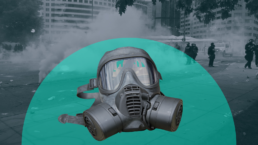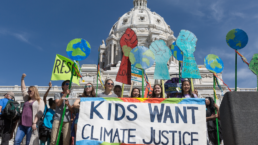Julia Conley, Common Dreams
Following a call by Rep. Cori Bush to investigate the use of tear gas on civilians by law enforcement, the House Oversight Committee on Thursday released a memo showing that the federal government has never determined the unregulated chemical to be safe for use on humans—despite the fact that manufacturers earn millions of dollars per year providing tear gas to police departments across the country.
Reps. Raja Krishnamoorthi (D-Ill.) and Jamie Raskin (D-Md.), who chair the Oversight Committee’s panels on economic and consumer policy and civil rights liberties, respectively, released the memo decrying “a complete void in the regulation of tear gas, a weapon that is banned in war yet commonly used against U.S. citizens.”
The memo comes more than a year after the killing of George Floyd by former Minneapolis police officer Derek Chauvin sparked nationwide racial justice protests, where tear gas and other violent crowd control methods were frequently deployed by law enforcement agencies.
“Tear gas is not an inconvenience, it is a weapon of war,” said Bush (D-Mo.), who led civil rights demonstrations near St. Louis following the police killing of Michael Brown in 2014, in a statement Thursday. “I know what it’s like to have tear gas fired at me—my eyes, skin, and lungs burning in the fog of that horrific weapon—and to desperately search for something to relieve the terrible pain.”
“For too long, tear gas has been abused by law enforcement,” the congresswoman added.
Rep. Alexandria Ocasio-Cortez (D-N.Y.), also a member of the Oversight Committee’s civil rights panel, said the widespread use of tear gas shows that “the current design of our law enforcement is militarized.”
A staff memo released today from two @OversightDems subcommittees found that tear gas is unregulated, harmful to humans, and lines the pockets of tear gas manufacturers.
— Rep. Alexandria Ocasio-Cortez (@RepAOC) October 14, 2021
The current design of our law enforcement is militarized.
We need to ban tear gas.https://t.co/atHl9jPDqP
According to the two subcommittees’ investigation:
- The U.S. has not conducted epidemiological research to determine the safety of tear gas when used on humans;
- Tear gas manufacturers acknowledge that tear gas is dangerous and that “injury and/or damage can be expected”; and
- Despite knowing the safety risks, manufacturers defer to law enforcement agencies regarding the use of tear gas and “some law enforcement associations eschew strict standards for tear gas use.”
The subcommittees noted that widespread use of tear gas against protesters in the U.S.—including at one protest in June 2020 in Washington, D.C., where former Attorney General William Barr reportedly directed authorities to remove demonstrators, leading to the use of force—persists despite the United Nations’ ban on tear gas in conflict zones.
Raskin and Krishnamoorthi requested information from multiple federal agencies including the Environmental Protection Agency (EPA), the Department of Health and Human Services (HHS), and the Department of Justice regarding efforts to regulate tear gas, studies on the effects of the chemical on human health, and “the feasibility of establishing universal standards for tear gas products.”
Each agency responded briefly, confirming they do not “regulate tear gas” and are “not aware of any activities or actions regarding tear gas.”
The memo notes that what little research has been done on tear gas was largely conducted around 1950 and only included animals and young men in good health.
As Common Dreams reported earlier this year, one recent survey by Kaiser Permanente Northwest found that hundreds of people exposed to tear gas at protests in Portland last year experienced changes in their menstrual cycles including intense cramping, blood clots, and abnormally long periods.

Despite those findings, which were made public in April, the federal government has made no moves toward regulating the use of tear gas against civilians.
In contrast, the subcommittees pointed out that “in a 2014 study focused on U.S. Army recruits, scientists found that even young, healthy individuals developed a high risk of acute respiratory illness after exposure to tear gas. As a result, the Army immediately limited exposure concentrations and exposure times.”
“Tear gas is dangerous, and despite this, manufacturers have continued to profit off its sale.”
The investigation also found that three manufacturers of tear gas—Pacem, Combined Systems, and Safariland—generated more than $13 million in revenue between January 2018 and June 2021, selling the product to police departments and corrections facilities.
“Tear gas is dangerous, and despite this, manufacturers have continued to profit off its sale, and law enforcement agencies have had free rein to use it against protesters across the country,” said Bush. “This unregulated, violent, and deadly chemical weapon can cause long-lasting health damage to activists, including asthma, respiratory failure, and even death. It is past time our nation reckoned with its ongoing history of racial, social, economic, and environmental violence.”
In addition to this year’s survey showing widespread menstrual changes in people exposed to tear gas, a 2017 study published in BMC Public Health regarding the use of chemical irritants including tear gas and pepper spray showed that out of 5,910 people exposed around the globe, two died from the exposure and more than five dozen suffered permanent disabilities.
Exposing people engaged in civil disobedience to such potential outcomes, said Bush, violates Americans’ First Amendment rights.
“For protest to truly be a right,” said the congresswoman, “we must ensure that we are never again met with weapons of war on our streets.”
Recent Posts
Stop Israel’s Dystopian “Humanitarian City” Plan—Before It’s Too Late
July 11, 2025
Take Action Now For the past 20 months, the world has watched—and largely enabled—a genocidal campaign in Gaza. Over 55,000 Palestinians have been…
The “Liberal” International Order Is Criminalizing Palestine Protests
July 11, 2025
Take Action Now As Western governments repress Palestine solidarity and enable Israel’s impunity, the “liberal international order” is no longer…
Politicians Are Betraying Gen Z On Climate
July 10, 2025
Take Action Now While Gen-Zers thrift, knit, crochet, and find other ways to reduce our footprints, Trump and the GOP are greenlighting more climate…
Trump’s Deportation Threat Against Zohran Mamdani Is Shameful
July 10, 2025
Take Action Now In only half a year of Donald Trump’s presidency, he and his allies have turned deportation into an explicitly political threat…




